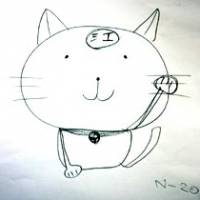A retired mannequin sculptor who fashioned his entire career out of observing women's curves is now eyeing curves of an even more mystical kind: those of the manekineko, the good-luck "beckoning cat" statues found all over Japan in the corners of bars, restaurants and lottery-ticket booths, where their presence is believed to act as magnet for money.
Since retiring from Tokyo-based mannequin-maker Tomane Co. in May, 70-year-old Makoto Kakeda has been lecturing part-time at Edogawa University in Nagareyama, Chiba Prefecture. There, among other projects, he has been working with his students to create new interpretations of manekineko, whose stylized appearance with one paw raised has barely changed since the homegrown charms became popular in the late Edo Period, more than 150 years ago.
But according to historian Shoichi Inoue in his 1998 book "Ningyo no Yuwaku (The Allure of Dolls)," the origin of the "beckoning cat" dates back much further, to the day in the 17th century when a samurai named Naotaka Ii passed by Gotokuji Temple in Tokyo. As he did, so the story goes, a cat emerged and motioned Ii and his men inside -- just as a sudden thunderstorm hit the area in what is now Setagaya Ward. The Ii clan was so moved by the incident that it became the temple's sponsor and made a beckoning cat its symbol.
Kakeda's interest, however, lies less in the history of manekineko than in redesigning them to appeal to modern sensibilities. "Traditional manekineko are, umm, not very appealing to me," remarked the amicable, down-to-earth sculptor, who has designed mannequins for fashion brands such as Chanel and Yves Saint Laurent. "By working with young people, I would like to update manekineko so more shops will feel like displaying them."
The timing and venue of his project couldn't be better. The sleepy, agrarian community of Nagareyama is now undergoing a massive, mega-yen redevelopment following this summer's opening of the Tsukuba Express rail line, which halved traveling time to central Tokyo to 30 minutes. As a result, the city is now looking to add more than 60,000 new residents by 2020, and Kakeda hopes that his project will not only embody the spirit of the growing city, but help it find a new identity.
But collaborating with whimsical non-art majors -- Kakeda's students at Edogawa University are students of mass communication -- can be quite challenging.
In his course, titled "City Revitalization and Event Planning," he divided his 30 students into six groups and then let them loose to freely draw their favorite cat images. He was surprised to find, however, that many were so shy that they could only scribble a few tiny doodles -- claiming it was the first drawing they'd done since their childhood.
Whatever their efforts looked like, though, Kakeda photocopied and enlarged them until they "really seemed to come to life." Then, during two sessions in October, he projected slides of these images for his students and asked them to award points to each. That way, they whittled the images down to 12 "designs," two of which Kakeda then assigned to each of the six groups to create three-dimensional figures using wire, tissue and clay.
Next, the students were asked to paint their feline figurines in whatever colors they liked -- though Kakeda also asked his professional illustrator friends to come up with some suggestions.
Through all this, it was clear that though some students tackled the assignment quietly and seriously, others seemed to take it merely as a chance to chat. Nonetheless, by the end they had created a colorful collection of manekineko wearing everything from scarves and overalls to heavy mascara -- and all were delighting in their shared sense of accomplishment.
"When I was first asked to draw a picture of a cat, I never imagined it would end up looking like this," said Kaori Suzuki, 20, her face alight with smiles. "Actually, I kind of want to take it home and put it in the entrance as an ornament."
"Whether they are skilled with clay or color is not important," Kakeda said, adding that he can now proudly ask city planners to adopt the objects as Nagareyama's new symbols. "It is their ideas and tastes that are important. And I think these works speak volumes about that."






















With your current subscription plan you can comment on stories. However, before writing your first comment, please create a display name in the Profile section of your subscriber account page.